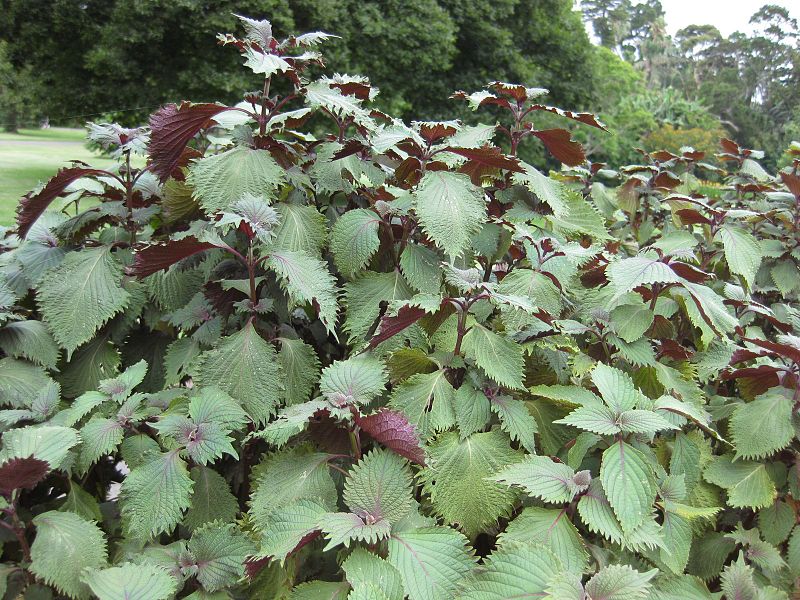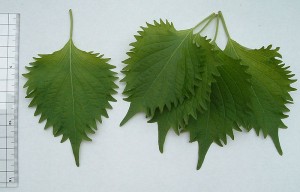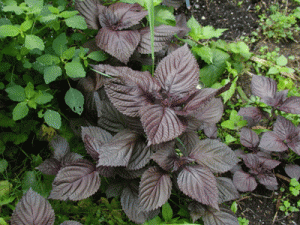The first Perilla I ever had came from a can, just like the kind sardines snuggle in. The leaves were very spicy and were used that way, as a spice. Later in my garden I grew the plant, which reseeded itself. That’s probably why Perilla is naturalized in the eastern half of North America excluding Vermont, New Hampshire, Maine and Canadian points north and east. Its native land is India.
Strictly speaking Perilla is a monotypic genus. (See article on monotypic genus.) There is only one species in the genus, but three are varieties. There are two major forms of cultivated Perilla, green and red though green is the most common escapee I have seen. Those common names are slightly misleading. The “Green” version is green on top of the leaf, and purple below. The “red” version has leaves that are purplish on top and bottom.
Perilla has been used as a salad ingredient, potherb and for its seed oil for literally thousands of years. And while the seed oil is edible — up to 64% Omega 3 fatty acids — it may not be the best oil to cook with. The oil, similar to unrefined Canola oil, has a chemical that is a potential lung toxin. The oil also has been used for lamps, which might be a dangerous use regarding potential lung damage. (Unrefined Canolia oil — rape seed oil — was used for cooking in India and a common cause of lung problems.)
According to the Federal Department of Agriculture Perilla has three chemical that are known lung toxin to cattle; egomaketone, isoegomaketone, and perilla ketone, the latter the most abundant and worse. Tests show Perillla ketone also produced pulmonary emphysema in goats, mice and rats. It does horses as well. While humans eat the species with little issue it is best to use any seed oil cold not heated.
In the greater mint family, noses and palettes disagree on what Perilla tastes and smells like, from cinnamon to licorice. I lean towards spicy cinnamon. It has numerous common names, among them Ao Shiso, Beefsteak Plant, Ji Soo, Perilla, Purple Perilla, Shiso, Wild basil, Wild Red Basil, Chinese Basil, Purple Mint, Rattlesnake Weed, Summer Coleus and Perilla Mint. In some individuals the plant can cause dermatitis.
Why the genus was called Perilla by the Latin scholar Linnaeus is debatable. It could mean “little bag” referencing the caylex. Despite what Internet “Baby Name” sites say Perilla (per-RILL-ah) is not an American invention, though it was a common girl’s name in the 1800s in the United States. Perilla was the nick name of Caecillia Metella the poetess, and lover of the Ancient Roman poet Ticida, and many others. Ticida (probably Clodius Aesopus) was not political but besides writing poetry he provided supplies to Julius Caesar’s army in 46 BC. Caecillia also seduced several of Julius Caesar’s intimate friends and was involved in much political scandal and intrigue. Soon married and divorced Caecillia was a talented, savvy, good looking party girl who probably wrote erotic poetry and is also called Lesbia in other poems. We know that Ticida invented the name “Perilla” for her by using Greek word play on her family name Metella. When she died we do not know. Thus what was a common proper name in the 1800s for girls in America was at its invention used to protect the public identity of a woman who wrote racy erotic poetry and slept around. And perhaps that is why the species is called Perilla, it’s attractive, spicy, and gets around. Frutescens (frew-TESS-enz) means shrubby or bushy.
Green Deane’s “Itemized” Plant Profile: Perilla
IDENTIFICATION: Perilla frutescens: Stems to a yard high, erect, herbaceous, purple, four-angled, a single vertical groove on each side of the stem. Leaves are opposite, petiolate, purple with a very shallow groove. Blades ovate, serrate, acute, to four inches long (10cm) three inches wide (8cm) sometimes crisped (curled or undulated) or not, typically green above and purple-green or entirely purple below, mostly hairless above, hairy on the veins below. Flower spikes growing out of where a leaf stem meets a main stem or at the top end of the plant. Blossoms pink, four stamens, anthers pinkish, fading to purple, two blossoms per node, each with a folded bract. Bracts broadly ovate when unfolded.
TIME OF YEAR: Flowering August to October.
ENVIRONMENT: Gravel bars, rich soils, alluvial soils or dry soils along streams, spring branches, gravel bars, roadsides, railroads.
METHOD OF PREPARATION: Leaves used as a coloring or a spice. Flower spikes in soup or fried. Seeds uses as a spice or a source of edible oil. Sprouts cooked and eaten like a potherb.




